





 |
 |
 |
 |
 |
 |
| A Math Toolbox in Every Home
|
help students make and use math manipulatives
* benefits of students making manipulatives |
| *
What are some big ideas in the creation of math manipulatives by students?
|
| *
free and inexpensive materials for making manipulatives:
free:
|
| *
types of manipulatives:
|
| *
What are some big ideas in students' use of portable handmade math manipulatives?
|
| *
Base Ten blocks
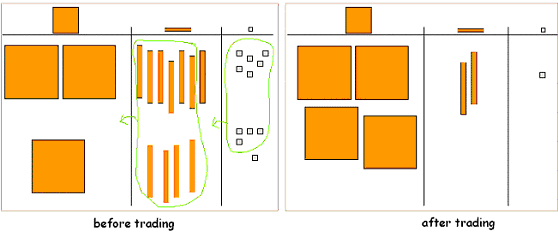
Color and cut out your own Base Ten blocks and use them to illustrate addition, subtraction, multiplication, and division problems on a place value mat or board.
Materials: graph paper, crayons, posterboard, glue, scissors (optional: magnetic tape)
Color a few sheets of graph paper orange and glue them onto posterboard. Glue an uncolored half-sheet of graph paper, too. Cut the uncolored graph paper into square units. If you are using centimeter graph paper, each square will equal one unit. If you are using ¼" graph paper, each unit will be two squares wide and two squares long. Cut the orange sheets into 10-rods (one unit by ten units) and 100-squares (10 units by 10 units).
Optional: Cut small pieces of magnetic tape and press a piece onto the back of each one-unit. Press two or three pieces onto the 10-rods, and place one piece in each corner of the 100-squares.
Use magnetic Base Ten blocks on a metal board or a refrigerator; make a place value mat as shown and tape it to the metal surface. Use non-magnetic Base Ten blocks and place value mat on a desk or table.
To add, set up each number on the place value mat. If you have more than ten ones, trade ten of them for one 10-rod. If you have more than ten 10-rods, trade ten of them for one 100-square.
When subtracting, if you need more tens or ones, you can trade one 100-square for ten 10-rods or one 10-rod for ten ones.
To multiply, set up groups of equal size and then regroup. For instance, to multiply 47 x 3, set up 3 groups of 47 (with 4 tens and 7 ones in each group), then regroup 20 of the ones into 2 tens to have 14 tens in all; then regroup 10 tens into one 100.
To divide, split a large number into an equal number of smaller groups, regrouping as needed.
|
| *
Cuisenaire rods:
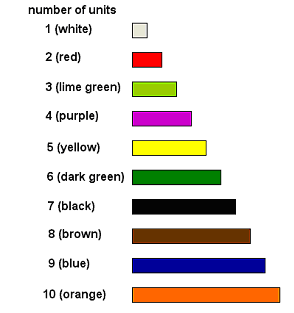 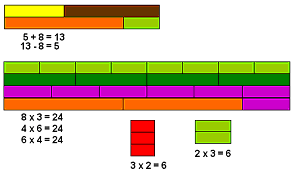
Color and cut your own magnetic Cuisenaire rods and use them to illustrate addition, subtraction, and multiplication problems.
Materials: graph paper, crayons, posterboard, glue, magnetic tape, scissors
Cuisenaire rods are rectangular rods of different colors and lengths. Use the side of a crayon to color half-sheets of graph paper matching the rods on the diagram. Glue each sheet onto posterboard. Cut each paper into strips of the right length along the gridlines. If you are using centimeter graph paper, each square will equal one unit. If you are using ¼" graph paper, each unit will be two squares wide and two squares long.
Cut small pieces of magnetic tape and press a piece onto the back of each short rod. Press two or three pieces onto the longer rods.
To add, make "number trains" of two or more rods end-to-end. Measure each train using orange 10 rods and one smaller rod if necessary.
To subtract, start with a train of one orange rod and one smaller rod. Place a rod above this train, lined up with its right end. See what other rod is needed to complete the train.
To multiply, make a train of one color and measure its length with orange rods and one smaller rod. You can also make one-color "rugs." Try to make two different rugs which have the same number of units.
|
| *
pattern blocks:
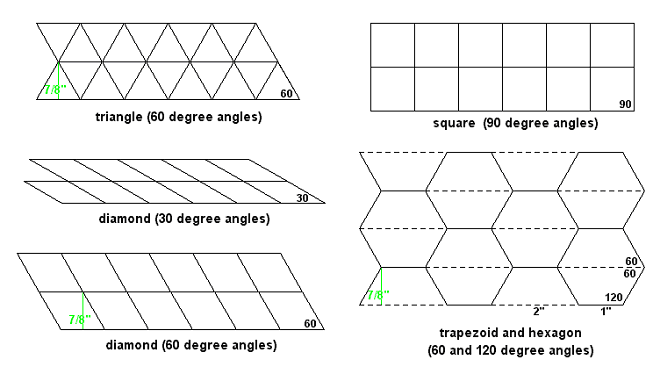 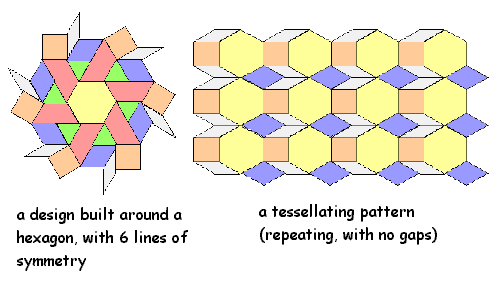
Make your own magnetic pattern blocks and use them to make colorful designs.
Materials: posterboard in six light colors, ruler, protractor, pencil, magnetic tape, scissors
You will be drawing rows of pattern block shapes to cut out. For most of the shapes, you will not need to measure angles at all; four of the shapes use 60 degree angles, and the spacing of the rows ends up being 7/8 inch. Squares with 90 degree angles can also be drawn with just a ruler. Use pale shades of posterboard so that you can see your patterns clearly. Choose a different color for each shape.
Draw the patterns:
Square: Place your ruler at the bottom left edge of the posterboard and mark off each inch. Mark off five or more inches along the left edge and also above your last bottom-edge mark. Connect these marks to make several parallel lines, one inch apart. Mark every inch along the top line. Connect these marks with the bottom marks to complete a grid of 1" squares.
Thick diamond (rhombus): Place your ruler at the bottom left edge of the posterboard and mark off each inch. Place your ruler along the left edge and make six marks spaced 7/8 inch apart. Repeat above your last bottom-edge mark. Connect these marks to make six parallel lines, 7/8 inch apart. On the lowest line above the bottom edge, make a mark ½" from the left edge. Shift your ruler over to this mark and mark off every inch. On the next line up, mark off every inch, starting from the left edge. On the third line up, once again begin your marks ½" from the left edge. Place your ruler at an angle and connect your marks from each row to the next, extending up through the remaining lines.
Triangle: Repeat all of the directions for the thick diamond. After you connect all of your marks with your ruler at one angle, pivot your ruler and connect all of the marks at another angle, forming a series of triangles which alternate between right-side-up and upside-down.
Trapezoid: Place your ruler at the bottom left edge of the posterboard and mark off a pattern: 2", 1", 2", 1", and so on. Place your ruler along the left edge and make six or more marks spaced 7/8 inch apart. Repeat above your last bottom-edge mark. Connect these marks to make several parallel lines, 7/8 inch apart. On the lowest line above the bottom edge, make a mark ½" from the left edge. Shift your ruler over to this mark and mark off this pattern: 1", 2", 1", 2", and so on. On the second line up, mark off the same pattern as you did on the bottom edge (2", 1"), starting from the left edge. On the third line up, once again begin your marks ½" from the left edge and mark off the pattern of 1", 2". Continue in this way until you have marked each line. Connect the marks between each row and the next to get rows of trapezoids which alternate between right-side-up and upside-down.
Hexagon: Repeat all of the directions for the trapezoid, but draw lightly. Erase every other horizontal line segment (the dotted lines in the diagram) and you will have staggered rows of hexagons.
Thin diamond (rhombus): Place your ruler at the bottom left edge of the posterboard and mark off each inch. Place your protractor over the last mark and measure a 30 degree angle. Measure another 30 degree angle from one of the other marks, at least several inches away. Use your ruler to connect the marks to draw the two angles and extend these angled lines for about 6 inches. Carefully mark off each inch along these slanted lines. Connect each pair of marks to draw a series of parallel lines; they will be slightly more than ½" apart. On the top line, mark off every inch from the intersections. Connect these marks with the bottom-edge marks to draw lines parallel to the two angled lines, forming rows of thin diamonds.
Cut and use:
Carefully cut out each set of patterns. Cut small pieces of magnetic tape and place one piece on each shape. Use the pattern blocks to make designs on a metal board or a refrigerator. You can make tessellating patterns (patterns which repeat with no empty spaces) or you can build a design around a hexagon which has six lines of symmetry. Or see if you can use the pattern blocks to create geometric animals, people, or scenes.
|
| *
tangrams:
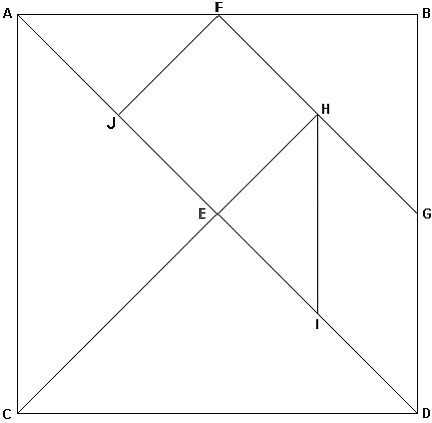
Make your own tangrams by folding and cutting without drawing a line!
Materials: stiff paper, scissors (optional: magnetic tape)
You'll be making a series of folds, creasing well, opening the paper flat again, then cutting along the fold. If your paper is rectangular, you can create a square by folding from the bottom left corner (C) up to point B and creasing along line AD, then cutting off the excess paper above line AB.
Fold and cut along AD.
In the lower triangle, bring point A to point D and crease along CE. Cut.
Bring point B to the opposite edge at point E. Crease along FG. Cut.
Bring point A to point D. Crease along EH. Cut.
Bring point E to the opposite edge at point G. Crease along HI. Cut.
Bring point A to point E. Crease along FJ. Cut.
If you like, add magnetic tape to the back of each piece for use on a metal surface. There are many online sources for tangram designs.
|
| *
magnetic multiplication grid:
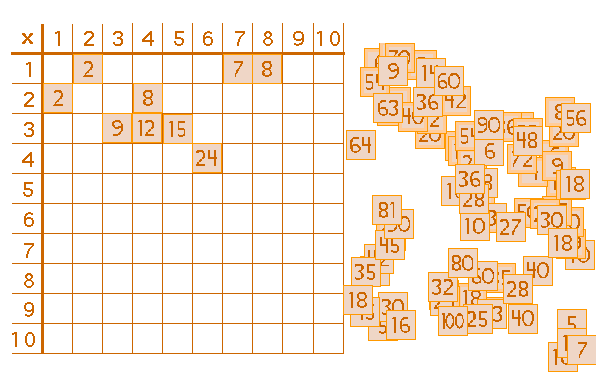
Make 100 magnetic number squares and use them on a metal grid to practice the multiplication facts up to 10 x 10.
Materials: posterboard, ruler or yardstick, pencil, colored marker, magnetic tape, scissors, metal board, permanent marker, small container
Use your ruler to measure and draw 100 one-inch squares in a 5" by 20" grid on the posterboard. Cut the squares apart carefully.
Use a marker to number your squares, beginning 1 - 10. Number the second 10 squares counting by twos: 2, 4, 6, 8 and so on. Number the next 10 squares counting by threes. Continue this way until you number the last 10 squares counting by tens.
Cut ¼" lengths of magnetic tape, peel off the backing, and press one piece of magnetic tape to the back of each square. Store your number squares in a small box or plastic container.
Now, make a multiplication board. Draw a grid on a metal board with permanent marker, or else draw your grid on large paper and tape it to your refrigerator. You'll need an 11 x 11 grid of 1 ¼" squares. Place an X in the top left square. Fill in the top row and the left column with the numbers 1 - 10. See how fast you can fill in the 100 empty squares with your 100 number squares. The more you play, the faster you get!
|
| *
egg carton math:
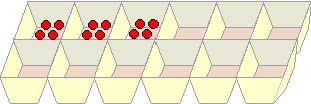 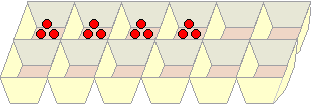
Use an egg carton to help you multiply as you sort small objects into groups.
Materials: egg carton, small objects (beads, beans, cereal), containers, thick paper cut into 20 cards, marker
Number two sets of cards from 1 - 10 and place them in a container. Place each kind of small object into its own container. Pull two cards from the container number container. You'll use the egg carton and the small objects to multiply these two numbers together.
Let's say the two cards are 5 and 6. You can say "5 times 6" or "5 groups of 6." Use five sections of the egg carton and place 6 objects in each section. You can count 6 objects into the first section, then 6 objects into the second section, and so on. Or you can pass them out one at a time, the same way you might deal cards in a card game: put one object into each of five sections, then put another object into each sections, until you have placed six objects in each section.
You can reverse the order of the same two cards and say "6 times 5" or "6 groups of 5." Now use six sections of the egg carton and place 5 objects in each section.
Did You Know? An egg carton is a 2-by-6 "array" (an orderly arrangement of objects in rows and columns).
|
| *
resources:
Safe-T Compasses and Protractors
magnetic tape
free printable graph paper
free printable protractors and cm rulers
thick paper (cover stock and index paper) |
| *
printable instructions for making and using many manipulatives:
"A Math Toolbox in Every Home" (Word document)
|
| © copyright 2007 - Wendy Petti of Math Cats. All Rights Reserved. |